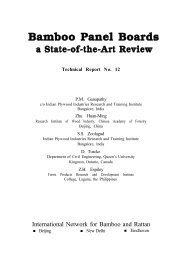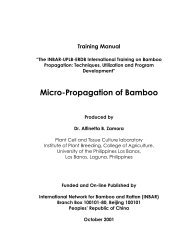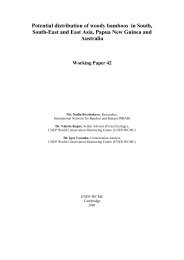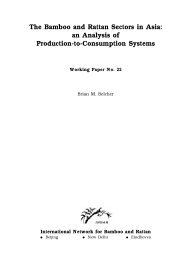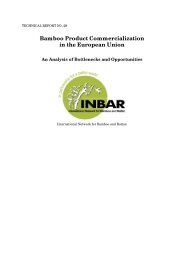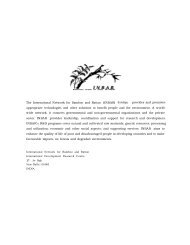- Page 1 and 2: BAMBOO FOR PULP AND PAPER A State o
- Page 3 and 4: PREFACE Bamboo is regarded as a maj
- Page 5 and 6: PREFACE ACKNOWLEDGEMENTS CONTENTS P
- Page 7: Anatomy and Chemical Constituents 3
- Page 11 and 12: 3. CHEMICAL CONSTITUENTS AND FIBRE
- Page 13 and 14: mechanical and chemical processing)
- Page 15 and 16: 4. PROCESSES AND PRINCIPLES 4.1. Me
- Page 17 and 18: 4.2.1. Alkaline pulping processes T
- Page 19 and 20: By addition of 0.05 per cent AQ, th
- Page 21 and 22: In the kraft semichemical process,
- Page 23 and 24: cellulose derivative must first be
- Page 25 and 26: 4.2.4.3. Nitric acid pulping The ni
- Page 27 and 28: commune (Ramaswami and Ramanathan 1
- Page 29 and 30: Pulp bleaching chemicals can be cla
- Page 31 and 32: Hypochlorite can be used in a singl
- Page 33 and 34: pH. The use of bio-catalysts can ac
- Page 35 and 36: continuously. The second major type
- Page 37 and 38: which they are manufactured. An ext
- Page 39 and 40: 5.3. History of pulp production fro
- Page 41 and 42: El Bassam and Jakob (1996) 146 repo
- Page 43 and 44: Prophylactic treatment with a mixtu
- Page 45 and 46: making with bamboo(Singh 1989) 77 p
- Page 47 and 48: var. pubescens; Razzaque et al. (19
- Page 49 and 50: The difference in the lignin conten
- Page 51 and 52: Within a culm, the proportion of di
- Page 53 and 54: indicates its suitability for pulp
- Page 55 and 56: High-yield and good quality pulp, e
- Page 57 and 58: 9.2. Chemical pulping Bamboo pulp h
- Page 59 and 60:
therefore, not only beneficial at l
- Page 61 and 62:
carefully chosen cooking conditions
- Page 63 and 64:
and burst index by about 15 per cen
- Page 65 and 66:
digestion with hot water (150 0 C)
- Page 67 and 68:
obtained at an impregnation tempera
- Page 69 and 70:
percentage of hardwoods in the mixt
- Page 71 and 72:
(Ku and Pan 1975) 224 . Chang and D
- Page 73 and 74:
hardwoods (50:50 mixture) was descr
- Page 75 and 76:
adverse effects are not much (Suman
- Page 77 and 78:
11. BEATING As bamboo fibres are he
- Page 79 and 80:
12. PULP AND SHEET CHARACTERISTICS
- Page 81 and 82:
conditions, from 41-47 per cent (Ch
- Page 83 and 84:
Scandinavian birch (0.66) and eucal
- Page 85 and 86:
14. TYPES OF PAPER Experiments cond
- Page 87 and 88:
effective cooking is not the length
- Page 89 and 90:
and knotter (nodes) rejects in a ba
- Page 91 and 92:
7. Bambusa bambos (Syn. Bambusa aru
- Page 93 and 94:
15. Bambusa oldhamii Mechanical pul
- Page 95 and 96:
Fibre morphology; effect of age on
- Page 97 and 98:
30. Dendrocalamus latiflorus Indust
- Page 99 and 100:
34. Gigantochloa aspera Chemical co
- Page 101 and 102:
48. Ochlandra scriptoria (Syn. Ochl
- Page 103 and 104:
57. Phyllostachys pubescens Mechani
- Page 105 and 106:
71. Teinostachyum dullooa (Syn. Neo
- Page 107 and 108:
APPENDIX - 2 A. Proximate chemical
- Page 109 and 110:
A. Survey of pulping processes APPE
- Page 111 and 112:
B. Non-conventional pulping procedu
- Page 113 and 114:
C. Characteristics of rayon grade p
- Page 115 and 116:
C. The symbols used to describe the
- Page 117 and 118:
APPENDIX - 7 Mean values of strengt
- Page 119 and 120:
A. Grades of paper Sl No. APPENDIX
- Page 121 and 122:
3 Wrapping or bag papers - Kraft pa
- Page 123 and 124:
7 Bristol 8 Paperboards - Boxboards
- Page 125 and 126:
either ply. Board with three or mor
- Page 127 and 128:
PART - III ANNOTATED BIBLIOGRAPHY
- Page 129 and 130:
December 1951, Dehra Dun. 1956. Vol
- Page 131 and 132:
Strength properties of the standard
- Page 133 and 134:
ellirica and 2.5 - 5 per cent each
- Page 135 and 136:
62. Pande, G.C. 1970. A modified te
- Page 137 and 138:
80. Stevens, R.H. 1958. Bamboo or w
- Page 139 and 140:
94. Gamble, J.S. 1896. The bambusea
- Page 141 and 142:
The suitability of bamboo species f
- Page 143 and 144:
123. Surendran, P.N. Status paper o
- Page 145 and 146:
Part I gives an account of investig
- Page 147 and 148:
154. Guha, S.R.D. 1961. Bamboo as a
- Page 149 and 150:
173. Maheshwari, S; Satpathy, K.C.
- Page 151 and 152:
A brief review of pre-and post-war
- Page 153 and 154:
206. Virtucio, F.D; Uriate, M.T; Ur
- Page 155 and 156:
Gives the results of chemical analy
- Page 157 and 158:
237. Singh, S.V; Rai, A.K; Singh, S
- Page 159 and 160:
degree of delignification. ABCP 18t
- Page 161 and 162:
With a view to possible utilization
- Page 163 and 164:
276. Bist, D.P.S; Singh, S.V; Singh
- Page 165 and 166:
292. Idei, T. 1981. D.P [degree of
- Page 167 and 168:
Acidolysis products of milled wood
- Page 169 and 170:
lignin content fell from 36.5 to 29
- Page 171 and 172:
follow a similar pattern. A conside
- Page 173 and 174:
351. Shanmughavel, P; Francis, K. 1
- Page 175 and 176:
362. Eberhardt, L. 1968. Hi-yield a
- Page 177 and 178:
Conventional soda pulping results i
- Page 179 and 180:
391. Gremler, E.R; McGorovern, J.N.
- Page 181 and 182:
407. Karim, M.S; Islam, M.A; Khalid
- Page 183 and 184:
indica and Ulmus [Pinus] wallichian
- Page 185 and 186:
Kraft Pulping 443. Alam, M.R; Barua
- Page 187 and 188:
457a. Guha, S.R.D; Singh, M.M; Shar
- Page 189 and 190:
Bamboo pulps with the best physical
- Page 191 and 192:
491. Ghosh, S.R; Saikia, C.N. 1996.
- Page 193 and 194:
506. Grant, J. 1964. Beating charac
- Page 195 and 196:
530. Roy, T.K; Bist, V; Pant, R. Bl
- Page 197 and 198:
544. Chandra, A; Guha, S.R.D. 1981.
- Page 199 and 200:
555. Kumar, S; Singh, M.M; Guha, S.
- Page 201 and 202:
566. Singh, M.M. 1977. Summary of F
- Page 203 and 204:
Das, S.C 233 Deb, D.B 90 Deb, U.K 2
- Page 205 and 206:
Lakshmana, A.C 106 Lakshmi Sharma 3
- Page 207 and 208:
Seethalakshmi, K.K 118 Sekhar, T 25



